|
|
|||

FOREST
HEALTH - FALL 2001 STATE MEETING
BEST WESTERN, NEWBERRY, MICHIGAN
16-17 OCTOBER, 2001
 Issues
about forest health engaged an audience for two days on 16 and 17 October in
the Newberry area at the 2001 Fall Meeting of the Michigan SAF. About 100 people
attended the combined indoor and outdoor program, arranged by Bob Heyd,
Rich Trevillian, and Les Homan.
Issues
about forest health engaged an audience for two days on 16 and 17 October in
the Newberry area at the 2001 Fall Meeting of the Michigan SAF. About 100 people
attended the combined indoor and outdoor program, arranged by Bob Heyd,
Rich Trevillian, and Les Homan.
Michigan SAF Chair, Roger Misiak, kicked off the program with opening comments.
Frank Sapio, Michigan DNR, provided an overview of forest health monitoring programs in the state. He highlighted a number of cooperative efforts with other agencies and previewed current and upcoming technology designed to aid in the evaluation of forest health.
Frank focused on the following
elements of statewide forest health monitoring.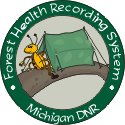
1. Integrated Pest Management
(IPM).
2. Interagency efforts.
3. Growing forest exotics concern.
4. New and developing technologies (i.e. IFMAP, digital aerial sketch-mapping).
5. New DNR on-line reporting system. [DNR
Forest Health Page]
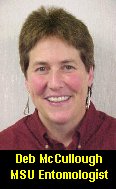 Deb McCullough, Michigan State University, spoke
about an impending outbreak of jack
pine budworm
(Choristoneura pinus), based on 2001 mortality in the Raco Plains area
of the eastern Upper Peninsula. The jack pine budworm is part of our native
system and we are due for another cyclical high within the next couple years.
Deb McCullough, Michigan State University, spoke
about an impending outbreak of jack
pine budworm
(Choristoneura pinus), based on 2001 mortality in the Raco Plains area
of the eastern Upper Peninsula. The jack pine budworm is part of our native
system and we are due for another cyclical high within the next couple years.
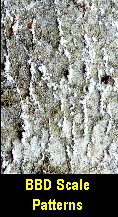 Beech
bark disease (BBD) was first discovered in Michigan
in 1999, although it has likely been here for at least a decade. Distribution
maps are updated frequently as observation reports are submitted. BBD is combination
of an exotic scale insect (Cryptococcus fagisuga) and at least two species
of Nectria canker, one native (Nectria galligena) and one exotic (Nectria
coccinea var. faginata).
Martin MacKenzie,
U.S. Forest Service from Morgantown, West Virginia, presented a case study of
the BBD in North America. The disease has killed large volumes of beech across
New England and eastern states. It’s a slow-acting disease but will result
in significant beech volume loss in Michigan over the next decade or so. MSU
produced an excellent publication which is also available on the MSAF website
(http://forestry.msu.edu/msaf/mainpage/BBD.htm).
Beech
bark disease (BBD) was first discovered in Michigan
in 1999, although it has likely been here for at least a decade. Distribution
maps are updated frequently as observation reports are submitted. BBD is combination
of an exotic scale insect (Cryptococcus fagisuga) and at least two species
of Nectria canker, one native (Nectria galligena) and one exotic (Nectria
coccinea var. faginata).
Martin MacKenzie,
U.S. Forest Service from Morgantown, West Virginia, presented a case study of
the BBD in North America. The disease has killed large volumes of beech across
New England and eastern states. It’s a slow-acting disease but will result
in significant beech volume loss in Michigan over the next decade or so. MSU
produced an excellent publication which is also available on the MSAF website
(http://forestry.msu.edu/msaf/mainpage/BBD.htm).
Sudden oak death (SOD) and the hemlock woolly adelgid are two exotics that are serious pests in other parts of North America but have yet to reach Michigan.
 Sudden
oak death
is a fungus (Phytophthora ramorum) that has killed a range of woody species
along the California coast. The fungus may have been introduced with rhododendron
imports from Europe, but the disease is so new that much remains to be learned.
The latest information can be obtained from the website (http://www.suddenoakdeath.org).
Sudden
oak death
is a fungus (Phytophthora ramorum) that has killed a range of woody species
along the California coast. The fungus may have been introduced with rhododendron
imports from Europe, but the disease is so new that much remains to be learned.
The latest information can be obtained from the website (http://www.suddenoakdeath.org).
The SOD upshot for Michigan is that the western bigleaf maple (Acer macrophyllum) has just been added to the susceptibility list. Acer spp. comprise nearly 30 percent of Michigan’s timberland volume. Threats to the maple resource are serious should our native maples prove to be susceptible. Andrew Storer, Michigan Technological University, provided background and current information about the new disease. Andrew is a recent addition to the Michigan forestry community, educated in England and comes our way via California.
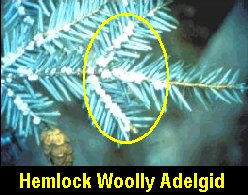 The hemlock woolly adelgid (HWA) (Adelges tsugae) is
an exotic insect from Europe that was introduced to North America around 1927.
Eastern hemlock (Tsuga canadensis) across New England and the northern Appalachians
has suffered extensive mortality. HWA is not yet in Michigan, although two cases
of infected nursery stock have been intercepted and treated. John Hill
of the Michigan Department of Agriculture explained the quarantine laws protecting
Michigan from early introduction, but it appears the insect will eventually
reach Michigan via natural vectors. News about the HWA can be found on the website
(http://na.fs.fed.us/fhp/hwa),
included biology, photos, distribution
maps, and details on the Michigan quarantine.
The hemlock woolly adelgid (HWA) (Adelges tsugae) is
an exotic insect from Europe that was introduced to North America around 1927.
Eastern hemlock (Tsuga canadensis) across New England and the northern Appalachians
has suffered extensive mortality. HWA is not yet in Michigan, although two cases
of infected nursery stock have been intercepted and treated. John Hill
of the Michigan Department of Agriculture explained the quarantine laws protecting
Michigan from early introduction, but it appears the insect will eventually
reach Michigan via natural vectors. News about the HWA can be found on the website
(http://na.fs.fed.us/fhp/hwa),
included biology, photos, distribution
maps, and details on the Michigan quarantine.
 Bob
Heyd, Michigan DNR, provided a review
of some the major pest events of 2001. Forest tent caterpillar (Malacosoma disstria) defoliated tree across
large acreages of the Upper Peninsula and populations may increase in the Lower
Peninsula in 2002. Jack
pine budworm
is on the move in the eastern U.P. Oak
wilt (Ceratocystis
fagacearum) continues to advance across the Lower Peninsula and eradication
efforts are underway in the southern U.P. Larch casebearer (Coleophora laricella) outbreaks in tamarack
continue throughout the state.
Bob
Heyd, Michigan DNR, provided a review
of some the major pest events of 2001. Forest tent caterpillar (Malacosoma disstria) defoliated tree across
large acreages of the Upper Peninsula and populations may increase in the Lower
Peninsula in 2002. Jack
pine budworm
is on the move in the eastern U.P. Oak
wilt (Ceratocystis
fagacearum) continues to advance across the Lower Peninsula and eradication
efforts are underway in the southern U.P. Larch casebearer (Coleophora laricella) outbreaks in tamarack
continue throughout the state.
 The evening featured a chicken and
ribs buffet catered by Timber Charlie’s of Newberry, followed by the Foresters
Fund Raffle and an Awards Program. Special thanks to Mike Elenz,
Frank Laurence, Todd Green, and
Mike Lanasa.
The evening featured a chicken and
ribs buffet catered by Timber Charlie’s of Newberry, followed by the Foresters
Fund Raffle and an Awards Program. Special thanks to Mike Elenz,
Frank Laurence, Todd Green, and
Mike Lanasa.
 A great program on Michigan moose was provided by Terry Minzey, of the Michigan DNR. Terry reviewed
the species taxonomy, history, biology, and current status. The focus for foresters
is a reminder of our effect on habitat conditions across our forests and how
dependent wildlife are on what we do, or don’t do. Continuing to blend
habitat considerations into our forest management, especially at the landscape
level, is critical to the welfare of Michigan wildlife and overall forest health.
A great program on Michigan moose was provided by Terry Minzey, of the Michigan DNR. Terry reviewed
the species taxonomy, history, biology, and current status. The focus for foresters
is a reminder of our effect on habitat conditions across our forests and how
dependent wildlife are on what we do, or don’t do. Continuing to blend
habitat considerations into our forest management, especially at the landscape
level, is critical to the welfare of Michigan wildlife and overall forest health.
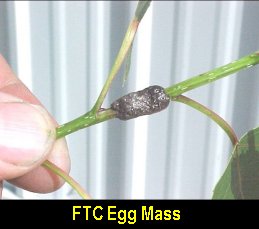 On
Wednesday, a field tour was arranged to see, first-hand, some of the concerns
in the forest.
On
Wednesday, a field tour was arranged to see, first-hand, some of the concerns
in the forest.
The tour began with a lesson in how to count forest tent caterpillar egg masses to predict the potential severity of a next season outbreak. Several aspen should be felled to reach the crowns. If a half-dozen egg masses can be spotted in five minutes, the next summer is likely to witness significant defoliation.
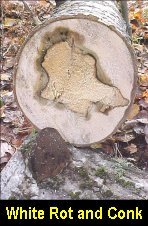 The
group used the same felled trees to see the effect of white trunk rot (Phellinus tremulae) in the aspen. A Minnesota
study by Jones & Ostry (Northern Journal of Applied Forestry, March 1998)
shows that past rule-of-thumb estimates based on conk appearance underestimated
trunk rot by 38 percent. The number of conks are predictive of volume loss from
2-32 percent. The average decay column extended five feet below the lowest conk
and eight feet above the upper conk.
The
group used the same felled trees to see the effect of white trunk rot (Phellinus tremulae) in the aspen. A Minnesota
study by Jones & Ostry (Northern Journal of Applied Forestry, March 1998)
shows that past rule-of-thumb estimates based on conk appearance underestimated
trunk rot by 38 percent. The number of conks are predictive of volume loss from
2-32 percent. The average decay column extended five feet below the lowest conk
and eight feet above the upper conk.
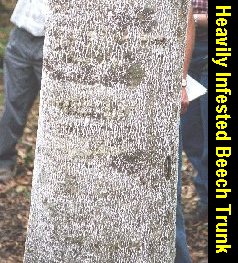 The
bus and truck caravan proceeded to Bass
Lake Campground,
the first site that beech bark disease was observed in the U.P. Excellent examples
of the scale populations and tar-spot and fruiting bodies of Nectria spp. were
seen. Genetic resistance is a key to maintaining beech in the forests of Michigan.
Identification of possible resistant trees was demonstrated by Shelter Bay foresters on properties they manage.
The
bus and truck caravan proceeded to Bass
Lake Campground,
the first site that beech bark disease was observed in the U.P. Excellent examples
of the scale populations and tar-spot and fruiting bodies of Nectria spp. were
seen. Genetic resistance is a key to maintaining beech in the forests of Michigan.
Identification of possible resistant trees was demonstrated by Shelter Bay foresters on properties they manage.
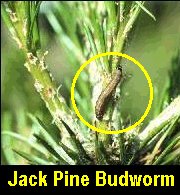
The last scheduled stop was a jack pine stand near Tahquamenon Falls State Park that was partially defoliated by the jack pine budworm the summer of 2001. Most of the dead needles had been washed off by recent rains, but thin crowns and pupal cases could be observed.
A Few Links to Forest Health / Insect & Disease Information
Beech Bark Disease (http://forestry.msu.edu/msaf)
Sudden Oak Death (www.suddenoakdeath.org)
Hemlock Woolly Adelgid (http://na.fs.fed.us/fhp/hwa)
Asian Long-horned Beetle (www.na.fs.fed.us/fhp/alb/index.shtm)
Pine Shoot Beetle (www.ceris.purdue.edu/napis/pests/psb/index.html)
MDNR Forest Health (www.michigan.gov/dnr/0,1607,7-153-30301_30505_30830---,00.html)
U.S. Forest Insect & Disease Leaflets (FIDLs) (http://na.fs.fed.us/pubs/fidl_hp.shtm)
MSU "CAT" Alerts - Landscape Edition (www.ipm.msu.edu/landCAT.htm)
Michigan Invasive Plant Council (www.msue.msu.edu/mipc)

This website is maintained by Bill Cook, Michigan State University Extension
Forest in the Upper Peninsula. Comments, questions,
and suggestions are gratefully accepted.
Last update of this page was 08 July 2003 . 21 September, 2005
This site is hosted by School of Forest Resources and Environmental Science at Michigan Technological University.